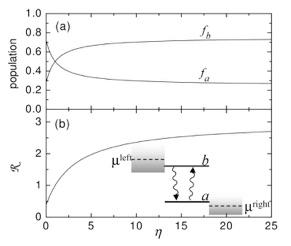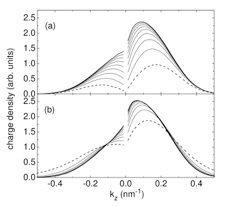

Quantum Transport phenomena and mesoscopic physics



The quantum wavelike nature of electrons becomes apparent in nanostructures at low temperatures. Indeed in this regime quantum phase coherence is preserved and the interference between electron waves may strongly affect transport properties. For these reasons these systems do not follow e.g. ordinary Ohm’s law, and are instead described by Quantum Transport theory. These features are the hallmark of Mesoscopic Physics, the field that investigates systems with a size much bigger than micro-scopic scale (like atoms or molecules) but still smaller than macro-scopic scale (where statistical mechanics and the usual Boltzmann equation are valid). These systems with ‘intermediate’ (mesoscopic) scale, typically from the micron down to the nanometer, are characterized by their own peculiar laws, where quantum effects must be taken into account.

➤ Electronic Noise in mesoscopic systems
A remarkable example of quantum electron interferometry is the Aharonov-Bohm effect, occuring in mesoscopic rings realized e.g. with semiconductor quantum wells or graphene. The interference conditions can be controlled by electrocal gates or by a magnetic flux threading the ring. In collaboration with F. Giazotto from the experimental group at NEST in Pisa, we have investigated a system realized with a mesoscopic ring contacted to two supercoducting electrodes.
It has been shown that, by exploiting the electro-magnetostatic Aharonov-Bohm effect in the ring, the supercurrent flowing through the system can be manipulated by tuning the parameters of the interferometers. In particular, not only the magnitude but also the sign of the supercurrent can be tuned. The system thus represents a fully tunable pi-junction. The system can be implemented by realizing Aharonov-Bohm rings with semiconductor heterostructures; highly transparent contacts between a semiconductor and superconducting electrodes (such as Niobium and Aluminium) can be obtained with appropriate gradual doping of the former.


➤ Tunable Josephson current
The current I flowing through a conductor exhibits fluctuations ΔI= I-⟨I⟩ in time, even when the applied bias V is constant. The frequency spectrum of the current-current fluctuations ⟨ΔI(t) ΔI(0)⟩ is the noise spectrum S(ω,V), where ω is the frequency, V is the applied voltage.
In collaboration with B.Trauzettel (Wuerzburg), I.Safi (Orsay), and H.Grabert (Freiburg), the current noise of a quantum wire capacitively coupled to a metallic gate has been investigated. In particular, it has been found out that, under suitable conditions, the noise at finite bias can be lower than the equilibrium noise, yielding a negative excess noise. This effect has been analyzed in different regimes of the capacitive coupling to the gate, band dispersion relation and impurities in the wire.
References
F. Rossi, Theory of Semiconductor Quantum Devices (Springer, Berlin Heidelberg, 2011)
F. Rossi, A. Di Carlo, and P. Lugli, Microscopic Theory of Quantum Transport Phenomena in Mesoscopic Systems: A Monte Carlo appraoch, Phys. Rev. Lett. 80, 3348 (1998).
R. Proietti Zaccaria, and F. Rossi, On the problem of generalizing the semiconductor Bloch equations from a closed to an open system, Phys. Rev. B 67, 113311 (2003).
D. Taj, L. Genovese, and F. Rossi, Quantum-transport simulations with the Wigner-function formalism: Failure of conventional boundary-condition schemes, Europhys. Lett. 74, 1060 (2006).
M. Pieruccini, S. Savasta, R. Girlanda, R. C. Iotti, and F. Rossi, Near-field light emission from mesoscopic complex structures, AIP Conf. Proc. 772, 671 (2005).
F. Rossi, A. Di Carlo, and P. Lugli, Microscopic theory of quantum-transport phenomena in mesoscopic systems, in Highlights INFM 1998/1999 (INFM, Genova, 2000) p. 81.
➤ Phase coherence vs dissipation in open quantum systems
The generalization of the conventional density-matrix formalism to physical systems with open spatial boundaries (i.e., quantum devices inserted into an electric circuit) is a highly non-trivial task; this is primarily ascribed to the non-local nature of quantum mechanics, which - opposite to the classical case - does not allow for a genuine separation between device active region and external carrier reservoirs. Such basic criticism applies specifically to the conventional Wigner-function formulation of the problem where, in spite of the non-local character of quantum mechanics, the presence of spatial boundaries is incorporated via the usual boundary-condition scheme of the classical (Boltzmann) theory.
References
F. Dolcini, Full electrical control of Charge and Spin conductance through Interferometry of Edge States in Topological Insulators, cond-mat ArXiv : 1011.4471.
F. Dolcini and H. Grabert, Tuning Excess Noise by Aharonov-Bohm Interferometry, Chem. Phys. 375, 291 (2010).
F. Dolcini, and F. Giazotto, The electro-magnetostatic Aharonov-Bohm effect as a tool to tune the Josephson current, Physica E 40, 2091 (2008).
F. Dolcini, and F. Giazotto, Switching the sign of Josephson current through Aharonov-Bohm interferometry, Phys. Rev. B 75, 140511 (2007).
F. Dolcini, B. Trauzettel, I. Safi, H. Grabert, Transport properties of single channel quantum wires with an impurity: Influence of finite length and temperature on average current and noise, Phys. Rev. B 71, 165309 (2005).
B. Trauzettel, I. Safi, F. Dolcini, and H. Grabert, Appearance of fractional charge in the noise of non-chiral Luttinger liquids , Phys. Rev. Lett. 92, 226405 (2004).

During the last decade, our group has definitely shown the intrinsic limitations of the conventional Wigner-function modeling of quantum-transport phenomena in systems with spatial open boundaries, proposing alternative strategies based, e.g., on fully quantum-mechanical projection schemes.


Nanophysics and Quantum Systems

